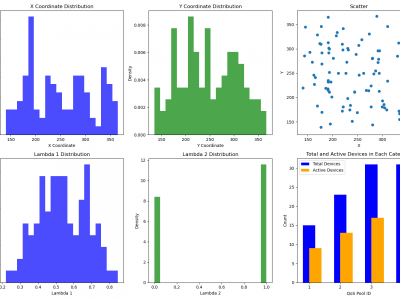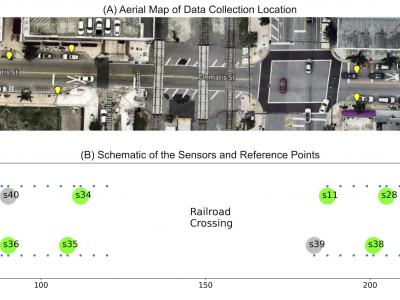Wireless Networking
The increasing prevalence of encrypted traffic in
modern networks poses significant challenges for network security,
particularly in detecting and classifying malicious activities
and application signatures. To overcome this issue, deep learning
has turned out to be a promising candidate owing to its ability
to learn complex data patterns. In this work, we present a
deep learning-based novel and robust framework for encrypted
traffic analysis (ETA) which leverages the power of Bidirectional
- Categories:
 211 Views
211 ViewsIn our research, we generate datasets utilizing two key statistical models: the Poisson Process Distribution and the Beta Distribution. These models are employed to simulate and analyze various aspects of Quality of Service (QoS) in Internet of Things (IoT) environments, with a particular emphasis on wireless communications. By leveraging these distributions, our study aims to optimize resource allocation, improve reliability, and ensure that QoS requirements are met in complex and dynamic wireless communication scenarios within IoT ecosystems.
- Categories:
 289 Views
289 ViewsIntrusion detection in Unmanned Aerial Vehicle (UAV) networks is crucial for maintaining the security and integrity of autonomous operations. However, the effectiveness of intrusion detection systems (IDS) is often compromised by the scarcity and imbalance of available datasets, which limits the ability to train accurate and reliable machine learning models. To address these challenges, we present the "CTGAN-Enhanced Dataset for UAV Network Intrusion Detection", a meticulously curated and augmented dataset designed to improve the performance of IDS in UAV environments.
- Categories:
 1311 Views
1311 Views
The dataset accompanies the study titled “Rate Adaptation Algorithms in WLANs: A Comparative Analysis of Iwl-Mvm-Rs and Minstrel-HT Under Different Frame Error Causes.” This dataset contains simulation results that evaluate the performance of the Iwl-Mvm-Rs and Minstrel-HT Rate Adaptation Algorithms (RAAs) under varying frame error conditions, specifically low Signal-to-Noise Ratio (SNR) and collision-induced errors.
The data was generated using ns-3 simulations across four scenarios:
- Categories:
 45 Views
45 ViewsThis dataset consists of network packet traces collected in 2023 on the 5G infrastructure deployed at Chalmers University of Technology.
The dataset includes 1,912 pcap files, distributed across 8 folders. Each pcap file captures 1 minute of encrypted network traffic generated by one of the following 8 popular mobile applications:
- Categories:
 930 Views
930 ViewsThe TiHAN-V2X Dataset was collected in Hyderabad, India, across various Vehicle-to-Everything (V2X) communication types, including Vehicle-to-Vehicle (V2V), Vehicle-to-Infrastructure (V2I), Infrastructure-to-Vehicle (I2V), and Vehicle-to-Cloud (V2C). The dataset offers comprehensive data for evaluating communication performance under different environmental and road conditions, including urban, rural, and highway scenarios.
- Categories:
 1196 Views
1196 ViewsThe Unified Multimodal Network Intrusion Detection System (UM-NIDS) dataset is a comprehensive, standardized dataset that integrates network flow data, packet payload information, and contextual features, making it highly suitable for machine learning-based intrusion detection models. This dataset addresses key limitations in existing NIDS datasets, such as inconsistent feature sets and the lack of payload or time-window-based contextual features.
- Categories:
 2291 Views
2291 Views
The dataset consists of uplink channel gains, downlink channel gains and uplink to downlink channel gains along with corresponding power allocations for uplink users and downlink users across all subcarriers. Additionally, it consists of NOMA decoding order for successful implementation of SIC at NOMA receiver. The number of UL users and DL users are considered as N=M=6, and subcarriers are S=9. Each column in the dataset is a sample for fading channel realization and it should be converted back to the matrix to compute sumrate.
- Categories:
 193 Views
193 ViewsA modern Wi-Fi-enabled device (e.g., a smartphone) can spontaneously emit unencrypted and anonymized signals to the environment in search of an access point. This signal is called a probe request. Since it is freely available in the open air, one can build a sensor from a Wi-Fi adapter to capture the signal. Once captured, its signal strength can be measured in the form of a Received Signal Strength Indicator (RSSI).
- Categories:
 197 Views
197 ViewsThis dataset was developed in the context of the NANCY project and it is the output of the experiments involving streaming a virtual reality (VR) video in a 5G coverage expansion scenario. Additionally, iPerf3 experiments in both TCP and UDP modes were carried out. The coverage expansion scenario involves a main operator and a micro-operator which extends the main operator’s coverage and can also provide additional services.
- Categories:
 172 Views
172 Views






